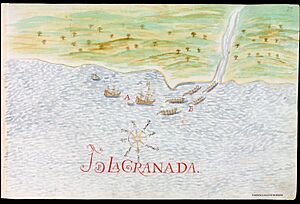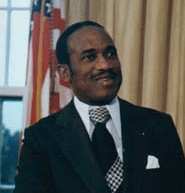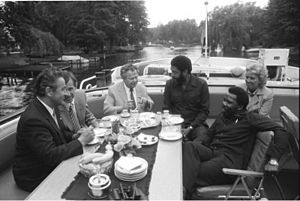History of Grenada facts for kids
The history of Grenada is all about the journey of this beautiful island in the Caribbean Sea. It's part of the Lesser Antilles island chain. From its very first people to becoming the country it is today, Grenada has a rich and exciting past.
Long ago, native people lived here. By the time Europeans arrived, the Caribs were the main group. Later, French settlers came. They fought with the Caribs and started large sugar farms. They brought many African slaves to work on these plantations.
In the 1700s, Great Britain and France often fought over who would control the island. Britain eventually won. In 1795, a big uprising called Fédon's Rebellion happened. It was inspired by the Haitian Revolution and almost succeeded. Slavery was ended in 1833. In 1885, St. George's, Grenada's capital, became the main city for the British Windward Islands.
Grenada became fully independent from Britain in 1974. A few years later, in 1979, there was a change in government by the New Jewel Movement. This led to the United States sending troops to the island in 1983. In 2004, Hurricane Ivan badly damaged the island's main crop, nutmeg.
Contents
Early Island Life

Grenada was formed by volcanoes about 2 million years ago. This volcanic activity created the land we see today.
Scientists believe people might have been in Grenada as early as 3760–3525 BC. This was during the Archaic Age. They found signs like charcoal, but it's hard to be sure if humans caused it. More certain signs of people come from shell piles at Point Salines, dated to 765 and 535 BC.
The oldest clear signs of human-made items are from the Early Ceramic Age. These settlements were at Beausejour (260–410 AD) and Pearls (370–645 AD).
Around 750 AD, more native people arrived, likely from South America. Most of the 87 ancient sites in Grenada show activity from 750–1200 AD. This was when Grenada's native population was at its largest. Different groups arrived over time, speaking languages like Arawakan.
Christopher Columbus is said to have seen the island in 1498 on his third trip. He didn't land, and the name he gave it, "La Concepcion," was never used. By the 1520s, the island was known as "La Granada." This name came from a city in Spain. Later, the French called it "la Grenade," which became "Grenada" in English.
For almost 150 years, Grenada remained free from European settlement. This was partly because the native people resisted. When the French finally settled in 1649, there were two main native groups. The "Caraibe" (Caribs) lived in the north. The "Galibis" lived in the south-east.
European Settlements (1600s)
English Attempts
In April 1609, three English ships arrived with 208 settlers. They landed near what is now St. George's. After a few months, the ships left to trade elsewhere. When they heard the colony was in trouble, they returned in September. The remaining settlers were taken back to England. We don't know exactly why the colony failed or how many people died. It might have been due to tropical diseases, fighting with natives, or a lack of food.
French Takeover
On March 17, 1649, a French group of 203 men arrived from Martinique. They were led by Jacques Dyel du Parquet, who was the Governor of Martinique. They landed at St. George's Harbour and built a fort. They quickly made a deal with the native Chief Kairouane to share the island peacefully.
However, fighting broke out between the French and the islanders in November 1649. The conflict lasted for five years until 1654. The last native resistance was defeated. Instead of giving up, Chief Kairouane and his followers chose to jump off a cliff. This event is remembered in stories and poems. Even after this, people from St. Vincent continued to raid Grenada. They had helped the local islanders fight the French.
French Rule
In 1650, du Parquet bought Grenada, Martinique, and St. Lucia. Later, in 1657, he sold Grenada. In 1664, King Louis XIV of France bought the island. Grenada became a French colony, managed from Martinique. In 1675, Dutch ships briefly captured Grenada, but a French warship quickly took it back.
British and French Battles (1700s)
French Colony Life
By 1700, Grenada had 257 white settlers, 53 mixed-race people, and 525 slaves. There were sugar farms and many indigo farms. Between 1705 and 1710, the French built Fort Royal in St. George's. Today, it's known as Fort George. When sugar farms struggled, people started growing cocoa and coffee. This led to more small farms. In 1738, the first hospital was built.
British Rule Begins
Britain captured Grenada during the Seven Years' War on March 4, 1762. No fighting was needed. Grenada was officially given to Britain by the Treaty of Paris in 1763. In 1766, a strong earthquake hit the island. In 1767, a slave uprising was stopped.
In 1771 and 1775, St. George's, which was built mostly of wood, burned down. After this, it was rebuilt using stone and brick. Under British rule, many French properties were bought by Britons. Rules were also put on the Catholic church, which caused problems because most people still spoke French.
France recaptured Grenada from July 2–4, 1779, during the American War of Independence. A British rescue force was defeated in the naval Battle of Grenada. However, the island was given back to Britain by the Treaty of Versailles in 1783. In 1784, the first newspaper, the Grenada Chronicle, started.
Fédon's Rebellion
Julien Fédon, a mixed-race landowner, started a rebellion against British rule on March 2, 1795. His forces attacked towns like La Baye and Gouyave. Fédon was inspired by the ideas of the French Revolution. French advisors also supported him at first.
From March 1795 to June 1796, Fédon and his fighters controlled most of Grenada. Only the area around St. George, the government's seat, remained British. During this time, thousands of enslaved people joined the rebellion. About 7,000 died in the final attack on Fédon's mountain hideout in June 1796. This place is now called Fedon's Camp. After the rebellion was crushed, hundreds of rebels were caught and publicly executed. But Fédon himself was never found.
Changes in the 1800s
Early 1800s
In 1833, Grenada became part of the British Windward Islands Administration. It stayed this way until 1958. Slavery in British areas was officially ended in 1834. However, the last enslaved African people were truly freed in 1838. Nutmeg was brought to Grenada in 1843. A merchant ship on its way to England from the East Indies introduced it.
Late 1800s
In 1857, the first immigrants from East India arrived. In 1871, Grenada got its first telegraph connection. In 1872, the first high school was built. On December 3, 1877, Grenada's government changed to a direct "Crown colony" system. This meant Britain had more direct control.
In 1885, the capital of the British Windward Islands moved from Bridgetown to St. George in Grenada. This happened after Barbados left the group. From 1889 to 1894, the 340-foot Sendall Tunnel was built for horse carriages.
Road to Independence (1900–1974)
Early 1900s
The census in 1901 showed Grenada's population was 63,438. In 1917, T.A. Marryshow started the Representative Government Association (RGA). This group pushed for a new government system where Grenadians could have more say. Because of Marryshow's efforts, a commission in 1921–1922 agreed that Grenada was ready for some changes.
From 1925, Grenadians could elect 5 of the 15 members of the Legislative Council. However, only the wealthiest 4 percent of adults could vote. In 1928, electricity was installed in St. George's. In 1943, Pearls Airport opened. On August 5, 1944, the Island Queen ship disappeared. All 56 passengers and 11 crew were lost.
Towards Freedom (1950–1974)
In 1950, Grenada's constitution was changed. The number of elected seats on the Legislative Council increased from 5 to 8. These seats would be elected by all adults in the 1951 election. In 1950, Eric Gairy started the Grenada United Labour Party. It began as a trade union. This party led a big strike in 1951 for better working conditions.
This strike caused a lot of trouble. Many buildings were set on fire, and people called it the "red sky" days. British authorities had to send in soldiers to help restore order. On October 10, 1951, Grenada held its first general elections where all adults could vote. Gairy's party won six of the eight elected seats in both the 1951 and 1954 elections. But the Legislative Council still had little power. The colonial authorities were fully in charge.
On September 22, 1955, Hurricane Janet hit Grenada. It killed 500 people and destroyed 75 percent of the nutmeg trees. A new political party, the Grenada National Party, led by Herbert Blaize, won the 1957 election. With help from independent members, they took control of the Legislative Council from Gairy's party. In 1958, Grenada joined the Federation of the West Indies.
In 1960, a new position was created: Chief Minister. This made the leader of the main party in the Legislative Council the head of government. Herbert Blaize was the first Chief Minister. In March 1961, Gairy's party won the election again. George E. D. Clyne became Chief Minister briefly, then Eric Gairy took over in August 1961. Also in 1961, the cruise ship Bianca C caught fire in St. George's harbour. Everyone was rescued except for one engineer who died.
In April 1962, Grenada's Administrator (the Queen's representative) suspended the constitution. He removed Gairy as Chief Minister due to money problems. In the 1962 election, the Grenada National Party won again, and Herbert Blaize became Chief Minister for a second time.
After the Federation of the West Indies ended in 1962, Britain tried to form a smaller group of islands. When that failed, Britain and the islands came up with "associated statehood." This meant Grenada gained full control over its own affairs on March 3, 1967. Herbert Blaize was the first Premier of this new state. Eric Gairy served as premier from August 1967 until February 1974. His party won elections in 1967 and 1972.
Independence, Revolution, and US Invasion (1974–1983)
Independence
On February 7, 1974, Grenada became a fully independent country. It kept a government system similar to Britain's. There was a governor-general representing the British monarch (head of state). There was also a prime minister, who was the leader of the main political party and head of government. Eric Gairy was Grenada's first prime minister after independence. He served from 1974 until 1979.
Gairy won re-election in 1976. However, the opposition New Jewel Movement said the election was unfair. They then started working to overthrow Gairy's government. In 1976, St. George's University was founded.
The 1979 Change in Government
On March 13, 1979, the New Jewel Movement launched an armed revolution. They removed Gairy from power, stopped the constitution, and set up a new government. This was called the People's Revolutionary Government (PRG). Maurice Bishop became the prime minister. His government formed close ties with countries like Cuba and Nicaragua. All political parties except the New Jewel Movement were banned. No elections were held during the four years the PRG was in power.
The 1983 Events
On October 14, 1983, a power struggle happened within Bishop's party. He was placed under house arrest. His friend and rival, Deputy Prime Minister Bernard Coard, briefly became head of government. This led to protests across the island. On October 19, 1983, a crowd of Bishop's supporters freed him from arrest. However, Bishop was soon caught again by soldiers loyal to Coard. He was then killed along with seven others, including three government ministers.
That same day, the Grenadian military, led by Gen. Hudson Austin, took power. They formed a military government. A four-day curfew was announced. Anyone outside their home could be immediately punished.
Invasion
A force from the U.S. and Caribbean countries invaded Grenada on October 25, 1983. This action was called Operation Urgent Fury. They quickly defeated the Grenadian forces and their Cuban allies. During the fighting, 45 Grenadians, 25 Cubans, and 19 Americans died. This action was taken after a request from the governor general and the Organization of Eastern Caribbean States.
The United States also worried that the Soviet Union might use the island to gain power in the Caribbean. U.S. citizens were taken off the island. Grenada's constitutional government was then brought back. In 1984, the United States gave Grenada $48.4 million in aid.
In 1986, members of the PRG and the army were tried for their actions during the October 19 coup. Fourteen people, including Coard and his wife, were found responsible for the deaths of 11 people, including Maurice Bishop. Three other soldiers were found responsible for a lesser charge and given long prison sentences. These prisoners became known as the Grenada 17. In 1991, all the death sentences were changed to life in prison. In 2003, Amnesty International said their trial had serious problems. In 2009, the last seven prisoners were released after 26 years.
Democracy Returns (1983 to Present)
After the Invasion
When U.S. troops left Grenada in December 1983, Nicholas Braithwaite was appointed Prime Minister. He led a temporary government until elections could be held.
On October 28, 1984, the new Point Salines International Airport opened. This allowed large commercial planes to land in Grenada for the first time.
The first democratic elections since 1976 were held in December 1984. The Grenada National Party (GNP), led by Herbert Blaize, won 14 out of 15 seats. Blaize served as prime minister until he died in December 1989. The GNP stayed in power but with fewer seats. Some members left the GNP to form the National Democratic Congress (NDC). In 1989, Prime Minister Blaize formed another new party, The National Party (TNP). This split led to a minority government until the 1990 elections. Ben Jones became prime minister after Blaize's death until the 1990 elections.
The National Democratic Congress (NDC) won the 1990 elections. They got 7 of the 15 seats. Nicholas Brathwaite formed a coalition government with members from other parties. He became prime minister for a second time. Braithwaite resigned in February 1995. George Brizan then served as prime minister until the June 1995 election.
In the June 20, 1995, elections, the NNP won 8 of the 15 seats. They formed a government led by Keith Mitchell. The NNP won all 15 seats in the January 1999 elections. Mitchell won again in 2003, serving as prime minister for a record 13 years. He was defeated in 2008.
The 2001 census showed Grenada's population was 100,895.
The 2008 election was won by the National Democratic Congress (NDC). Tillman Thomas became prime minister, with his party winning 11 of the 15 seats.
In 2009, Point Salines International Airport was renamed Maurice Bishop International Airport. This was done to honor the former prime minister.
Recent Years (Since 2013)
In February 2013, the ruling National Democratic Congress (NDC) lost the election. The opposition New National Party (NNP) won all 15 seats. Keith Mitchell, the NNP leader, returned to power. He had served three terms as prime minister before.
In December 2014, Grenada joined the Bolivarian Alliance for the Peoples of Our America (ALBA). Prime Minister Mitchell said this was a natural step because of Grenada's cooperation with Cuba and Venezuela.
Mitchell has led the NNP to win all 15 seats in the House of Representatives three times. In November 2021, he said the next general elections would be his last.
In June 2022, the opposition National Democratic Congress (NDC) won the snap election. The NDC won nine of the 15 seats. Dickon Mitchell, the NDC leader, became the new prime minister. This meant Keith Mitchell, Grenada's longest-serving prime minister, lost his position.
Truth and Reconciliation
From 2000 to 2002, a "truth and reconciliation commission" was set up. It aimed to look into unfair events from the late 1970s and early 1980s. A Catholic priest, Father Mark Haynes, led the commission. It held many meetings across the country.
The commission was inspired by a school project. Students at Presentation Brothers' College (PBC) researched the time when Maurice Bishop was in power. They especially looked into why Bishop's body was never found. Their project gained a lot of attention. It also showed that many people in Grenada still felt hurt by those events. The commission started soon after the students finished their project.
Hurricane Ivan
On September 7, 2004, Hurricane Ivan, a very strong storm, hit Grenada directly. The hurricane destroyed about 85 percent of the buildings on the island. This included the prison and the prime minister's home. Thirty-nine people died. Most of the nutmeg crop, which is very important to Grenada's economy, was also destroyed. Hurricane Ivan set Grenada's economy back several years. Hurricane Emily then damaged the island's north end in June 2005.
See also
 In Spanish: Historia de Granada (pa%C3%ADs) para ni%C3%B1os
In Spanish: Historia de Granada (pa%C3%ADs) para ni%C3%B1os
- British colonization of the Americas
- French colonization of the Americas
- History of North America
- History of the Americas
- History of the British West Indies
- History of the Caribbean
- List of governors of the Windward Islands
- List of heads of government of Grenada
- Politics of Grenada
- Spanish colonization of the Americas
- West Indies Federation




